On September 6, 2024, the delightful aromas of food wafted from the Sinan Mansion in Shanghai, like an invisible web quietly spreading and attracting numerous visitors to embark on a wonderful experience of “Brain and Food.”
According to Professor Mao Ying, the initiator of the event, Dean of Huashan Hospital Affiliated to Fudan University and Director of the Clinical Translational Research Center of Tianqiao and Chrissy Chen Institute, this interdisciplinary science communication event is the first session of the “Brain Exploration” series, co-hosted by the Tianqiao and Chrissy Chen Institute (TCCI) and the Chinese Neuroscience Society. Several neuroscientists were invited to join renowned food critics in engaging the public through academic presentations, scientific experiments, and storytelling, sharing knowledge about how food influences cognition, emotions, and behavior.
1. Four Olfactory Truths Beyond Cognition
The book The Science of Tasting mentions five basic taste types: sour, sweet, bitter, salty, and umami. However, our rich food experiences result from the combined effects of multiple senses, including smell, taste, and touch, with olfaction playing a particularly crucial role. As Researcher Zhou Wen from the Institute of Psychology at the Chinese Academy of Sciences stated during the forum:
“Most perceptions of food flavors come from olfaction rather than taste.”
In fact, there are two main pathways for perceiving odors—the anterior nasal pathway and the posterior nasal pathway. The anterior pathway refers to odor molecules emitted by food entering through the nostrils and reaching the olfactory epithelium. Various olfactory receptors distributed on the olfactory epithelium convert chemical signals into electrical signals, which are then sent to the olfactory bulb, allowing us to smell the food’s aroma. The posterior pathway occurs during chewing; as food is heated in the mouth and mixed with saliva, its odor molecules enter the nasal cavity during exhalation, activating olfactory receptors in the same area and transmitting information to the olfactory bulb.
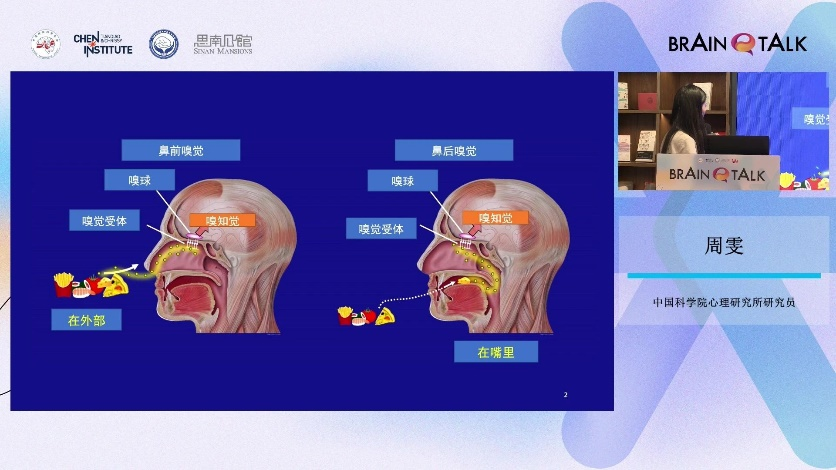
▷ Anterior and posterior nasal pathways for odor perception
“Odors do not exist as physical entities; they are encoded by neural networks in the brain.”
Odors are not inherently contained within the chemical molecules themselves; rather, they are processed by olfactory neurons in the brain to form a dynamic spatiotemporal pattern. Different odor molecules activate different glomeruli at various locations in the olfactory bulb, and the order of activation relates to the components and dynamic characteristics of the odor. Therefore, individual perceptions of odors include a high sensitivity to temporal information and responses to continuous changes.
In this way, our olfactory system acts like a “chemical analyst,” accurately analyzing the chemical composition of the environment and its dynamic changes. Olfactory information begins in the olfactory bulb and spreads via the olfactory tract to multiple key brain regions in the limbic system, such as the piriform cortex, amygdala (emotion center), and entorhinal cortex (brain GPS), resulting in the sensation of smell.
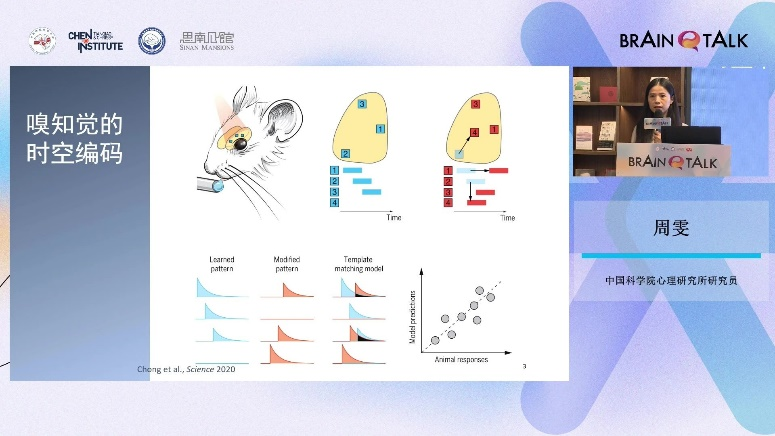
▷ Spatiotemporal Coding of Olfactory Perception
“Humans are also adept at using odors for localization, with abilities rivaling those of dogs, provided they get low enough.”
Since olfactory perception primarily involves ipsilateral conduction, the brain can accurately identify odors sampled from different spatial areas by the left and right nostrils. With two nostrils, humans theoretically possess the ability to perceive direction through smell to facilitate localization. A study on olfactory localization involving humans and dogs showed that [1], with appropriate training, blindfolded humans can effectively navigate using smell and continuously adjust their route, ultimately tracking down a target—chocolate.

▷ Olfactory Localization Experiment
Zhou Wen explained that her laboratory conducted a study on determining direction based on optic flow [2], which also found that when visual cues are insufficient to distinguish direction, our judgment of the direction of movement is influenced by the concentration of odors in the nostrils. The brain tends to perceive movement toward the side with the higher concentration. This implies that the brain can synthesize analysis based on odor concentration and provide directional clues. It’s no wonder people often find themselves wandering into the bakery section while shopping.
“Compared to other senses, olfaction more readily evokes memories and emotions.”
Odors can elicit rich emotional experiences and vivid memory fragments, often imbued with strong spatiotemporal information; specific smells can trigger unique memories of particular people or places. For example, the scent of braised pork may remind one of their mother and scenes from childhood when she was busy in the kitchen; a whiff of flowers may evoke memories of learning to ride a bike with a grandmother…
These spatiotemporal memories carried by smells benefit from the hippocampus’s [3] important role in memory formation, particularly in autobiographical recollection (personal past experiences). The transmission of olfactory signals and memory often impacts structures such as the amygdala and hippocampus, further linking emotions, memories, and spatiotemporal perception.
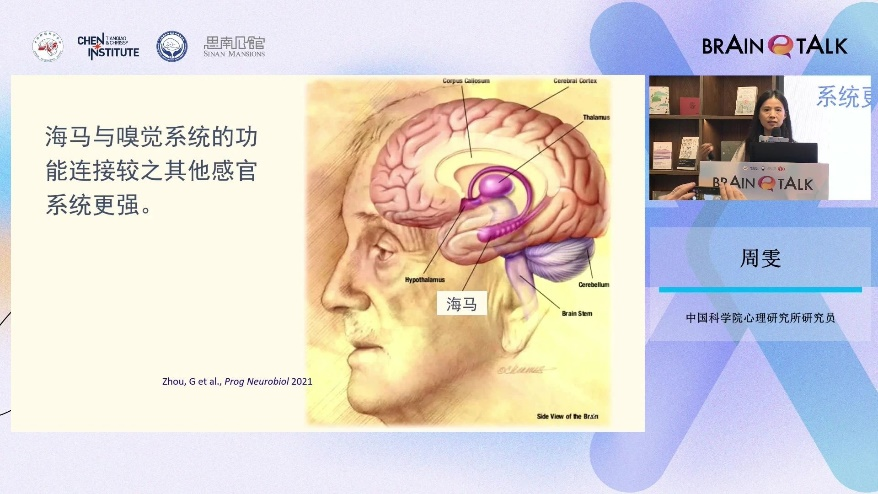
▷ Functional Connectivity of the Hippocampus and Olfactory System
Thus, losing the sense of smell means not only losing a part of sensory experience but also severing a rich emotional world associated with olfactory memories. If prolonged loss of smell occurs due to viral infections or neurodegenerative diseases, it may even affect an individual’s emotional state. To restore olfactory function, it is crucial to reestablish connections between smells and existing memories in the brain. For instance, when seeing soy sauce, one should strive to recall its scent, thereby strengthening neural connections and aiding olfactory recovery.
Olfaction is vital for most people, influencing not only daily life quality but also playing a key role in emotional connections and social interactions.
2. The “Manipulated” Eating Behavior
Olfaction helps humans locate food, but actual eating behavior is influenced by multiple internal and external factors, such as physiological state, the allure of food, and individual anxiety levels.
“CRHLHA neurons play a crucial role during eating.”
Researcher Xu Huatai from the Lingang Laboratory introduced a type of neuron in the lateral hypothalamus of mammals called corticotropin-releasing hormone neurons (CRHLHA neurons). These neurons become active during eating, and their firing activity can be observed and recorded in the laboratory. Seeing or smelling food can also stimulate the activation of CRHLHA neurons; during hunger, the activity level of CRHLHA neurons is higher than when satiated, reflecting dynamic changes in appetite.[4]
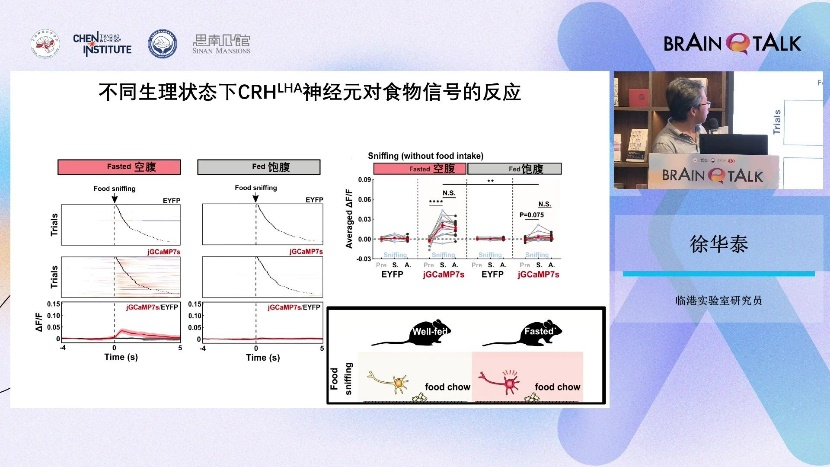
▷ Activity Levels of CRHLHA Neurons Reflect Appetite Changes
“Even when full, the deliciousness of food can entice further eating.”
Generally, after eating, our attraction to food decreases significantly. However, as the saying goes, “the stomach for meals and the stomach for dessert are never the same.” Even when satiated, CRHLHA neurons can become active again when faced with tempting chocolates or desserts, as if saying, “Just a little more.” Even the brain cannot resist the “pure pleasure” that delicious food brings.
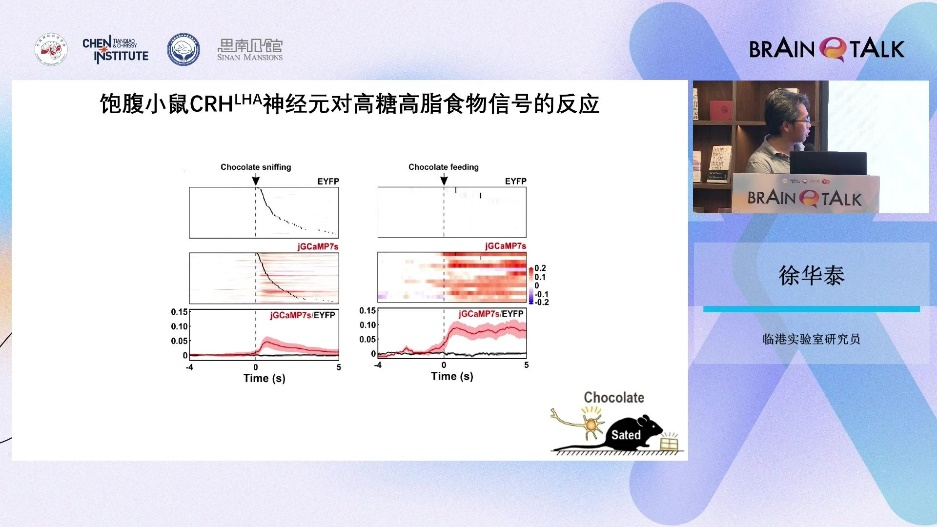
▷ CRHLHA Neurons Activate in Response to Preferred Food Signals When Satiated
“Eating and anxiety behaviors share a common neural circuitry.”
In nature, animals tend to reduce their eating frequency, activity level, and exploratory behavior under stressful conditions, demonstrating what is referred to as “eating anxiety.” In experimental studies, researcher Xu Huatai manipulated the activity of CRHLHA neurons in mice, achieving artificial control over their eating behavior and altering their perception of safety and anxiety levels.

▷ Eating and Safety Perception
By using optogenetic technology, researchers can increase or decrease the activity of CRHLHA neurons, leading to corresponding eating or refusal behaviors in the manipulated mice. In the experiments, artificially lowering the activity of CRHLHA neurons significantly reduced the eating behavior of hungry mice, even in the presence of enticing chocolates, which led to a decreased desire to eat. Conversely, artificially activating CRHLHA neurons caused the mice to “override their instincts,” increasing eating behavior and displaying risk-taking exploratory behavior.
Xu Huatai believes, “Current research results reveal the shared neural basis of eating and anxiety behaviors. However, changes in eating behavior under anxiety in humans are much more complex than in mice. On one hand, people rarely need to consider personal safety when eating in social settings; on the other hand, individuals react differently to anxiety, which can lead to extremes such as binge eating or anorexia.”
3. “Out of Control” Eating Motivation
Binge eating and anorexia are two manifestations of “out-of-control” eating motivation. Professor Zhou Yudong, Vice Dean of the School of Brain Science and Brain Medicine at Zhejiang University, explains that “eating behavior is primarily regulated by the reward center in the hypothalamus of the brain.”
“As a natural reward, food—similar to money, games, drugs, and maternal love—can enhance eating behavior through reinforcement.”
What constitutes “delicious food”? While foodies might offer poetic answers, for the brain, the answer may be quite straightforward: “high-energy” foods. Altering the composition of fats, proteins, or carbohydrates in food can effectively influence appetite. High-fat foods, in particular, are more likely to stimulate appetite compared to proteins and carbohydrates. Even in high-stress environments, high-fat foods can persistently drive foraging behavior, a phenomenon known as “compulsive eating” or “uncontrolled eating.”
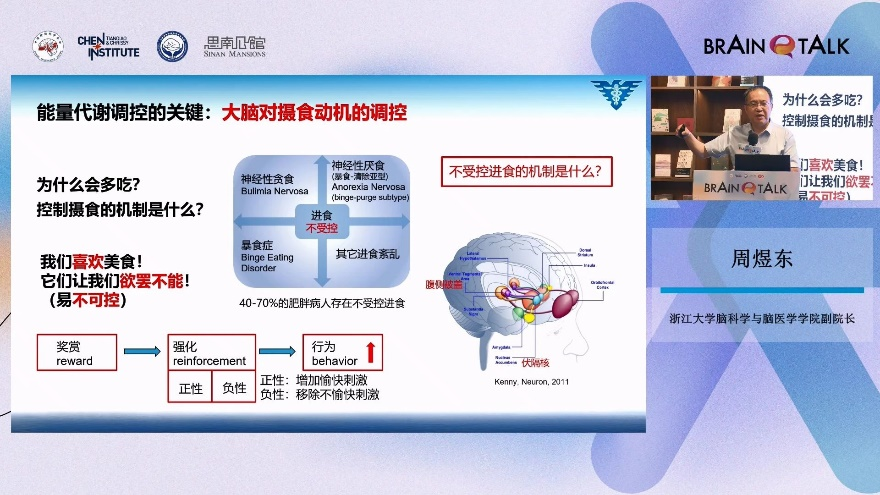
▷ Reward-driven Uncontrolled Eating Induced by Food
What changes occur in the brain that control eating motivation behind compulsive eating behaviors? Professor Zhou’s team discovered that,
“The anteroventral periventricular nucleus (aPVT) plays a key role in compulsive eating behaviors and approach-avoidance conflicts.”
In animal experiments, mice subjected to high-fat diets exhibited behaviors reminiscent of compulsive eating, such as overcoming fears of open spaces and electric shocks to forage boldly. Notably, activating aPVT neurons in normally fed mice resulted in behaviors similar to those of high-fat diet mice.[5]
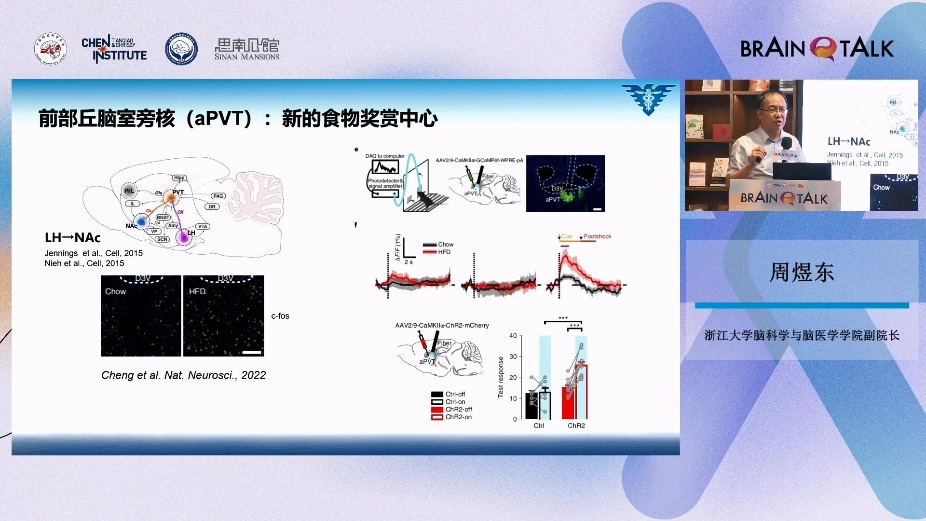
▷ aPVT: A New Food Reward Center
“The underlying mechanism of compulsive eating involves metabolic inflammation in the brain caused by excessive nutrient intake.”
Further research revealed that lipid molecules from high-fat food intake trigger inflammation in the aPVT region, promoting increased appetite and driving compulsive eating behaviors. This finding highlights the intricate connections between the nervous system, endocrine system, and immune system. Excessive energy intake leads to energy stress, resulting in central and peripheral metabolic inflammation. This may affect immune and metabolic functions, increasing the risk of metabolic diseases, neurodegenerative disorders (such as Alzheimer’s and Parkinson’s), cardiovascular diseases, and cancers.
Therefore, from a neuroscientific perspective, Professor Zhou reminds us, “There is a close relationship between food choices and disease, emphasizing the need to maintain a balanced diet for both physical and brain health.”
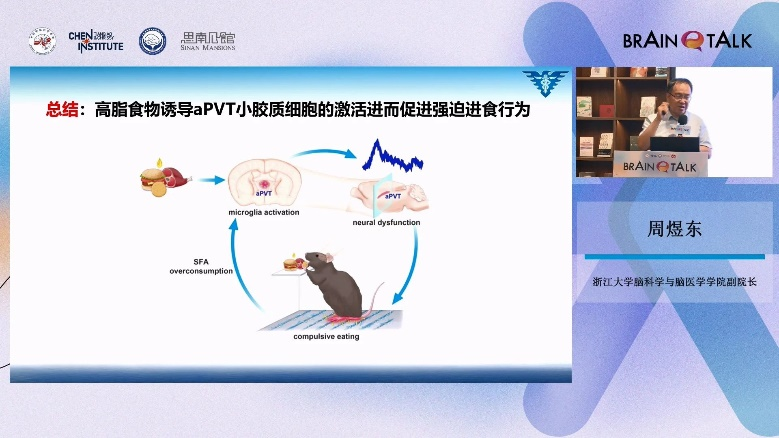
▷ High-fat diet induces inflammation in the aPVT brain region and promotes compulsive eating behavior
From the wondrous role of olfaction to the complex regulation of eating behavior and the phenomenon of “out-of-control” eating motivation, scientists at the “Brain and Food Forum” used vivid experiments and rigorous data to reveal the intricate neuroscience behind delicious food to both online and offline audiences. Looking ahead, as research in brain science continues to deepen, we anticipate uncovering more secrets of the interaction between food and the brain. This will enhance our understanding of human eating behavior and provide new ideas and methods for preventing and treating diet-related diseases.

▷ Scan the QR code above to view the full replay of the forum.
Support for science communication has always been a vital mission of the Tianqiao and Chrissy Chen Institute. In the future, the Tianqiao and Chrissy Chen Institute will continue the “Brain and Food Forum” format in collaboration with the Chinese Neuroscience Society, launching other diverse interdisciplinary exchanges such as “Brain and Sports” and “Brain and Visual Arts.” We hope to gather wisdom and resources from different fields to address complex issues in neuroscience research and deepen public understanding of the brain. We look forward to your participation!
[1] Porter, Jess, et al. “Mechanisms of scent-tracking in humans.” Nature neuroscience 10.1 (2007): 27-29.
[2] Wu, Yuli, et al. “Humans navigate with stereo olfaction.” Proceedings of the National Academy of Sciences 117.27 (2020): 16065-16071.
[3] Zhou, Guangyu, et al. “Human hippocampal connectivity is stronger in olfaction than other sensory systems.” Progress in neurobiology 201 (2021): 102027.
[4] Li, Song-Yun, et al. “CRH neurons in the lateral hypothalamic area regulate feeding behavior of mice.” Current Biology 33.22 (2023): 4827-4843.
[5] Cheng, Jingjing, et al. “Diet-induced inflammation in the anterior paraventricular thalamus induces compulsive sucrose-seeking.” Nature Neuroscience 25.8 (2022): 1009-1013.